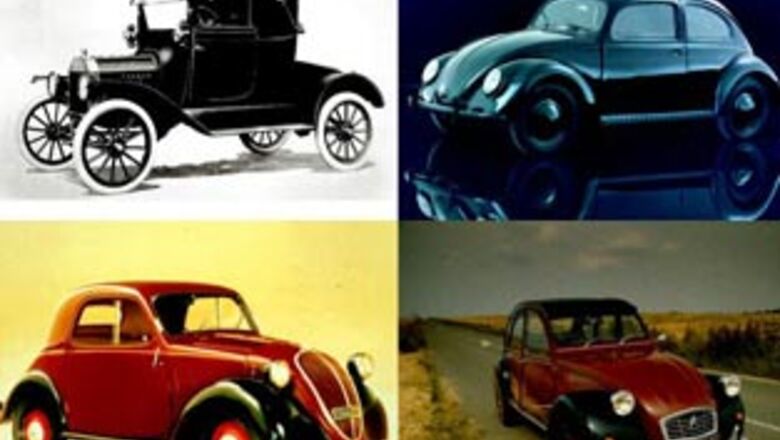
views
The people's car is not a new idea. At various times in history, a manufacturer has either recognised the demand for one, or has been forced by the need of the hour to create one. In every case, the car that has resulted has shared some common attributes – their inexpensive price tags, their reliability and in time, their iconic status. One thing is for sure, this is not the complete list of people's cars, but these four, we believe, are the most important icons of that popular category of cars.
Ford Model T
The Model T, or Tin Lizzie, predated other people's cars by a decade and was the first production car. This you know. Henry Ford's goal was simple, "I will build a car for the great multitude. It will be large enough for the family, but small enough for the individual to run and care for. It will be constructed of the best materials, by the best men to be hired, after the simplest designs that modern engineering can devise. But it will be low in price that no man making a good salary will be unable to own one - and enjoy with his family the blessing of hours of pleasure in God's great open spaces."
And in hindsight, he succeeded on all of those fronts, right? The 20.2hp, 2.9-litre inline four was reliable and powerful enough to drag the T to over 65kmph. Prices began at $850 in 1909 but fell to about $450 by 1915. Which was dirt cheap compared to the other cars at the time, which tended to stay over the $2,000 mark. Today, that would peg the Ford Model T at roughly $9120 or Rs 4.7 lakh.
Fiat Topolino
It wasn't quick, it wasn't fast, it was difficult to fix thanks to its size. But Fiat's Topolino ('Little Mouse', the Italian name for Mickey Mouse) was pleasing to look at, drank almost nothing and proved to be spacious. And that was enough to make it a legendary car. The Fiat 500 (official name) was produced from 1936 to 1955, although truth be told, it almost never got made.
The plan for the car was in the building back in 1919, but though brochures were printed, the car wasn't minted. In 1934, Agnelli, Fiat's boss visualised the 5,000 lire people's car that would carry two adults and 50kg of stuff. Dante Giacosa, a young aeronautical engineer worked on the powertrain while Rudolfo Schaffer created the two-part body.
The 500 was ready. It cost 8,000 lire, then, way over the target, but the buying public didn't notice, really. Until 1955, without any major mechanical mods, the Fiat 500/Topolino ran a 569cc four-cylinder side-valve water-cooled engine mounted ahead of the front axle. It could hit 85kmph, return almost 17kmpl and was priced at Lire 8900 (roughly $440, then), which, adjusted for inflation works out to $6620 (Rs 3.42 lakhs) today. In the 1955, the new 500 Fiat launched turned out to be so iconic, that the new one is remembered today as the Fiat 500, and not the Topolino.
PAGE_BREAK
VW Beetle
There's isn't much that hasn't been said about Volkswagen's Beetle. You should already know about its charm, how Hitler and Ferdinand Porsche had roles to play in its creation, how popular it was, and remains and so forth. The Type 1, as it was known internally, gained the name of Käfer, the German word for beetle, and that's what we know it has. Its spawned a variety of versions, and very few were officially called the Beetle. Point is, the car was a triumph of simplicity and reliability.
The original was supposed to carry two adults and three children at speeds of up to 100kmph. At launch, there was a special scheme that allowed Germans to buy the car for 990 Reichsmarks, roughly US$ 235. Adjusted for inflation that works out to US$ 3425 or Rs 1.8 lakh. That's roughly half the price of the Topolino - a contemporary people's car - mind you.
Obviously, the scheme included subsidised prices, but there it is – cheap and best. Ironic as it is, the Beetle and the factory it was made in almost didn't survive the aftermath of WWII. But it was the British – first due to their lack of interest in moving the factory to Britain, and later, due to British Major Ivan Hirst who extracted an unexploded bomb and restarted production - who are actually responsible for the Beetle's subsequent rise to popular cult icon.
Citroen 2CV
Pierre-Jules Boulanger wanted a small, cheap car ('umbrella on wheels') that would take two peasants, 100kg of produce at 60kmph, returning 33kmpl. And it would have to traverse a field without breaking the eggs it was carrying. The 'Deux Chevaux' did all of this, and how! Having somehow survived WWII, and in the process losing aluminium parts to steel, the final 2CV appeared in public in 1948 at the Paris Show.
At launch in 1949, the 2CV beat its many detractors by proving wildly successful among the lower-income populace. Within months, the waiting list grew to three years and used 2CVs were actually more expensive to buy because new ones would take time. The original 375cc flat-twin produced a laughable 9bhp, and the engine saw upgrades that, er, took care of the lack of power to some extent. But the 2CV was never about performance. It was reliable, cheap and it got the job done.
The thousands and thousands of buyers confirmed that it did that with a cheerful demeanour. By 1955, the 2CV was priced at roughly $1200 in the US. Today that would mean $9195 or Rs 4.75 lakhs.
The Tata Nano, as you can see already, will be part of this legend. In the past few decades, we've lost, to some extent, the focus on the people's car.
Ratan Tata has ensured, with the Nano, that popular cars for the populace will come back in fashion.
Click here to read more about Tata Nano



















Comments
0 comment